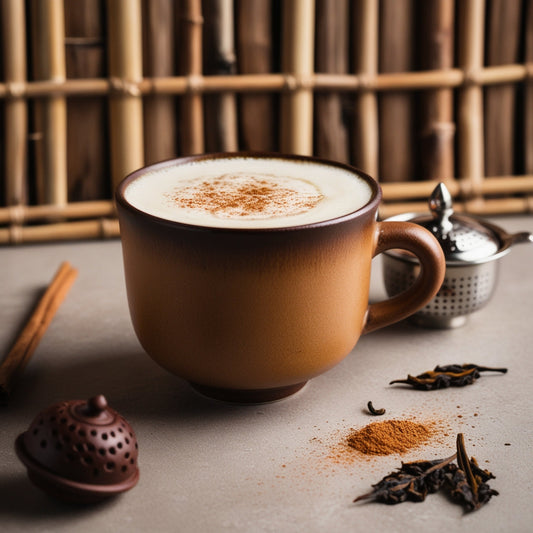Overview
Imagine sipping a cup of tea that not only delights your taste buds but also nourishes your body and mind. Green tea and rooibos tea, with their rich histories and diverse health benefits, offer just that. From the ancient traditions of China and South Africa to modern-day wellness routines, these teas have captivated tea lovers worldwide. This guide explores everything you need to know about green tea and rooibos tea—their origins, production processes, health benefits, brewing methods, flavor profiles, and caffeine content. Discover why these extraordinary teas deserve a special place in your daily routine and how they can contribute to a healthier, more vibrant you.
Table of Content
- Introduction
- Origins
- Production process
- Health benefits
- Brewing process
- Flavour profile
- Caffeine content
- Conclusion
Introduction
Tea enthusiasts and health-conscious individuals alike have long celebrated the unique flavors and impressive health benefits of green tea. Green tea, with its roots in ancient China, and rooibos tea, originating from the indigenous Khoisan people of South Africa, each offer a distinct drinking experience. While green tea is known for its refreshing, grassy notes and moderate caffeine content, rooibos tea boasts a naturally sweet, nutty flavor without any caffeine. Understanding the origins, production processes, health benefits, and brewing techniques of these teas can enhance your appreciation and enjoyment of these remarkable beverages. Let's explore the world of green tea and rooibos tea, discovering what makes each one special and beneficial for your health and well-being.
Origins
Green Tea
Green tea originated in China, where it was first steeped and consumed during Emperor Shennong's reign in 2737 BC. Buddhist monks later introduced this tea to Japan, and eventually, tea merchants spread it to various European countries.
Rooibos
The story began over 300 years ago with the indigenous Khoisan people, who harvested the Aspalathus Linearis plant for its leaves. They used these leaves as herbal remedies and enjoyed their delicious, aromatic taste. In 1772, European botanist Carl Thunberg observed the Khoisan climbing mountains to gather wild rooibos plants. His fascination with this practice revived a broader interest in rooibos tea.
Production Process
Green Tea
The production of green tea starts with harvesting the tea leaves, typically done by hand to ensure only the youngest and freshest leaves are selected. Once harvested, the leaves are quickly transported to a tea factory for processing. Green tea plantations and factories are primarily located in countries with a rich tea production tradition, such as China, Japan, India, and Sri Lanka. These countries offer ideal climates and geographical conditions for cultivating the Camellia sinensis tea plant and have accumulated extensive expertise in green tea cultivation and processing techniques.
Rooibos
The rooibos plant undergoes a harvesting and processing method similar to that used for the Camellia sinensis "true tea" plant. Harvesters cut the stems and leaves of the rooibos bush by hand and bind them into bundles. These bundles are then sorted and further cut to promote oxidation, which brings out the plant's natural essential oils and develops its color and flavor. Red rooibos, the most fermented and popular variety, undergoes more oxidation, resulting in a redder color and a sweeter, richer taste.

Health Benefits
Green Tea
Green tea offers a range of health benefits, including protection against Alzheimer's and Parkinson's diseases. Its polyphenol- and polysaccharide-rich leaves help lower and stabilize blood sugar levels. Compounds in green tea can block cholesterol absorption in the digestive tract, effectively lowering LDL cholesterol levels without affecting HDL levels. Regular consumption can lower the risk of cavities and other dental problems, as catechins and polyphenols act as natural fluorides that kill bacteria responsible for bad breath, cavities, tooth decay, and gum disease.
Drinking green tea can facilitate weight loss by slightly reducing body fat percentage and waist circumference. Polyphenols in green tea increase the rate at which the body transforms food into calories, while catechins promote weight loss. Additionally, green tea components like epigallocatechin gallate (EGCG) stimulate hair cell production and growth. Polyphenols in green tea work as powerful antioxidants, shielding skin from harmful free radicals, fighting signs of aging, treating skin ailments, and promoting longevity. The natural fluoride in green tea also contributes to bone density.
Rooibos
Rooibos is rich in antioxidants and is the only known source of the potent antioxidant aspalathin, which may help combat several lifestyle diseases. Unlike black and green teas, rooibos is naturally caffeine-free, making it suitable for children, infants, and breastfeeding mothers. It has demonstrated cancer-fighting properties in animal research studies, and new research suggests it may promote heart health and prevent diabetes. It contains low amounts of tannins, which are astringent, bitter-tasting plant polyphenols that can interfere with iron absorption in the body.
Brewing Process
Green Tea
- Water Temperature: Heat water to around 175°F (80°C). Boiling water can make the tea bitter.
- Tea Leaves: Use high-quality green tea leaves. Loose leaves are often preferred over tea bags for better flavor and health benefits.
- Steeping Time: Steep the green tea for about 2–3 minutes. Longer steeping times can make the tea bitter.
- Avoid Adding Milk: Adding milk to green tea can reduce the health benefits by binding to and neutralizing the antioxidants in the tea.
- Enjoy: Once it's steeped, remove the leaves and enjoy your cup of green tea.
Rooibos
- Boil Water: Use an electric kettle with temperature settings for ease. Boil more water than needed to warm up the teapot.
- Warm up the teapot. Pour some hot water into the teapot and swirl it around. Discard the water.
- Add Rooibos : Put rooibos tea into the teapot and add hot water. Cover and steepen.
- Strain: Strain the rooibos solids and pour the hot tea into a teacup. If desired, strain again using a fine mesh strainer to reduce the rooibos solids in your tea.
Flavor Profile
Green Tea
Green tea has a complex flavor profile, often described using words like grassy, earthy, and flowery. Moreover, this unique combination of flavors sets it apart from other types of tea.
Rooibos
This tea boasts a unique flavor profile, generally sweet and nutty with natural honey, vanilla, or caramel notes. It infusions have a light herbal taste and pair well with apple, chocolate, and berry fruit flavors.

Caffeine Content
Green Tea
An 8-ounce (230-ml) cup of green tea contains between 30 and 50 mg of caffeine.
Rooibos
Rooibos , derived from the Cape fynbos plant (Aspalathus linearis) native to South Africa, is a stimulant-free herbal tea as the plant naturally lacks caffeine.
Conclusion
Green tea and rooibos tea each offer unique and compelling benefits, from their rich historical roots to their distinctive flavors and numerous health advantages. Green tea, with its antioxidant properties and moderate caffeine content, can boost your alertness and support overall health, while rooibos tea, naturally caffeine-free and rich in unique antioxidants, is perfect for all ages and offers a sweet, nutty flavor profile.
Embrace the remarkable qualities of both green tea and rooibos tea by incorporating them into your daily routine. Start your journey towards a healthier lifestyle today by brewing a cup of green tea or rooibos tea.Enjoy the rich flavors, unique characteristics, and health benefits these extraordinary teas have to offer. Brew your first cup today and join the countless others who have made these teas a staple in their daily lives!
To further enhance your tea experience, expand your collection with Pu-erh tea from Puerh Craft. Its distinctive flavor and health benefits will perfectly complement your pursuit of greater vitality and relaxation, adding depth to your tea-drinking journey.
Q&A
Q: What are the origins of green tea and rooibos tea?
A: Green tea originated in China around 2737 BC, during Emperor Shennong's reign. It was later introduced to Japan by Buddhist monks and spread to Europe through tea merchants. Rooibos tea's history began over 300 years ago with the Khoisan people in South Africa, who harvested the Aspalathus Linearis plant. European botanist Carl Thunberg's fascination with their harvesting methods revived interest in rooibos in the 18th century.
Q: How are green tea and rooibos tea processed?
A: Green tea leaves are hand-harvested, then quickly transported to a factory and processed to prevent oxidation, thereby preserving their green color and nutrients. Major producers include China, Japan, India, and Sri Lanka. Conversely, rooibos tea involves cutting the stems and leaves, binding them into bundles, and allowing oxidation to enhance flavor and color. Furthermore, red rooibos undergoes more oxidation, resulting in a sweeter, richer taste.
Q: What are the health benefits of green tea and rooibos tea?
A: Green tea offers numerous health benefits, including protection against Alzheimer's and Parkinson's diseases, lower LDL cholesterol, improved dental health, weight loss, hair growth, and enhanced skin health. Rooibos tea is rich in antioxidants like aspalathin, supports heart health, helps prevent diabetes, and is naturally caffeine-free, making it suitable for children and breastfeeding mothers. It also contains low amounts of tannins, which do not interfere with iron absorption.
Q: How should green tea and rooibos tea be brewed?
A: To brew green tea, heat water to around 175°F (80°C) and steep high-quality loose leaves for 2-3 minutes. Avoid boiling water and adding milk to preserve its benefits. For rooibos tea, boil water and warm up the teapot, then steep the rooibos leaves and strain the solids. If desired, use a fine mesh strainer to reduce rooibos bits in the tea.
Q: What are the flavor profiles and caffeine content of green tea and rooibos tea?
A: Green tea has a complex flavor profile, often described as grassy, earthy, and flowery. Moreover, an 8-ounce cup contains 30–50 mg of caffeine. On the other hand, rooibos tea is sweet and nutty with natural honey, vanilla, or caramel notes, and pairs well with fruit flavors. Additionally, it is naturally caffeine-free, making it a stimulant-free herbal tea option.






